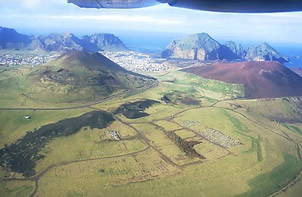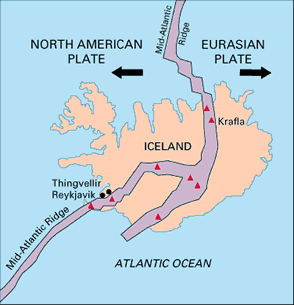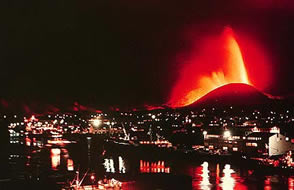Iceland:Heimay
World volcano Profiles >Europe > Heimay
 Heimay is a volcanic island off the southern coast of Iceland.In 1973 the Eldfell fell volcano erupted on Heimay threatening the nearby town of Vestmannaeyjir. Iceland lies just beneath the Arctic circle in the North Atlantic and is often called the "Land of Ice and Fire". This name comes from a the combination of 130 volcanic mountains, hydrothermal fields and extensive glaciers the largest of which is the Vatnajokull Glacier.
Heimay is a volcanic island off the southern coast of Iceland.In 1973 the Eldfell fell volcano erupted on Heimay threatening the nearby town of Vestmannaeyjir. Iceland lies just beneath the Arctic circle in the North Atlantic and is often called the "Land of Ice and Fire". This name comes from a the combination of 130 volcanic mountains, hydrothermal fields and extensive glaciers the largest of which is the Vatnajokull Glacier.
Driving in Iceland
An offroaders heaven! The main road around the perimeter of Iceland is paved but the interior roads are rough rock and gravel tracks and will involve river crossings so experience of 4WD , a map and of course a 4WD are essential. Make sure the petrol tank is full as petrol staions can be few and far between and non existent in the interior. Mountain Roads can be closed until June and those roads with an F prefix are only passable with a four wheel drive.The sign Malbik Endar means the paved road is about to run out - so slow down. Some river crossings can have water 4ft deep.
The Geology bit
 Icelands volcanoes owe their origin to the combination of two geological forces. Firstly Iceland sits upon the Mid-Atlantic Ridge ;this where the North American plate and the European plate are being pulled apart at about 5cm/year. As the Atlantic gets wider magma wells up from the mantle below creating new oceanic crust below the sea surface and new land above. The Mid-Atlantic ridge extends all the way to the South Atlantic as a narrow zone of spreading,rifting and volcanic activity on the ocean floor.
Icelands volcanoes owe their origin to the combination of two geological forces. Firstly Iceland sits upon the Mid-Atlantic Ridge ;this where the North American plate and the European plate are being pulled apart at about 5cm/year. As the Atlantic gets wider magma wells up from the mantle below creating new oceanic crust below the sea surface and new land above. The Mid-Atlantic ridge extends all the way to the South Atlantic as a narrow zone of spreading,rifting and volcanic activity on the ocean floor.
Secondly,Iceland rises above the sea due to an extra concentrated jet or pulse of magma called a hot spot or mantle plume which provides an extra boost of molten rock.
The rocks erupted are similar to Hawaii in that they are mainly basaltic and produce lava fountains and flows.Iceland has extensive Geothermal activity and is home to the original Geyser. Geothermal activity also provides home with hot water and electricity.
All over Iceland you will see columnar basalt columns. These polygonal sided columns form naturally as flood basalts cool and contract. Fartifoss waterfall is a good example of these.
Icelands volcanic regions of current activity are governed by the Mid Atlantic ridge which splits the country in two. Iceland deserves its own website to do it justice so here I have just given the volcanic highlights but rest assured there are many more things to see than just the big names.
Vestmann islands
The 18 Vestmann islands lie of the the SW coast of Iceland and are owe their origin to a 30km fissure trending SW to NE which is part of the Mid-Atlantic ridge. Heimaey is the only populated island with around 4500 residents most of whom are involved in the fishing industry. The islands are famous for their birdlife with an estimated 2 000 000 pufins in residence. The volcanic island of Surtsey is nearby but not accessible to the casual visitor as it a natural reserve.
Eldfell:Heimaey 1973
 Eldfell is a cinder cone 200m high on the island of Heimay in the Vestmann islands off the south west cost of Iceland. At 1.55am on the 23 january a fissure 1800m long opened up from one shore to the other. A curtain of fire and lava shot into the air 200m only 1km from the only town of Vestmannaeyjir. The population were evacuated by the fishing fleet. Houses were soon buried in tephra and the lava started advancing towards the towns harbour which was vital for the towns fishing fleet and livelyhood. The population were determined to save their harbour and pumped millions of tonnes of sea water onto the advancing lava front to cool the advancing flow. It worked and the lava flow in the end enhanced the harbour entrance.
Eldfell is a cinder cone 200m high on the island of Heimay in the Vestmann islands off the south west cost of Iceland. At 1.55am on the 23 january a fissure 1800m long opened up from one shore to the other. A curtain of fire and lava shot into the air 200m only 1km from the only town of Vestmannaeyjir. The population were evacuated by the fishing fleet. Houses were soon buried in tephra and the lava started advancing towards the towns harbour which was vital for the towns fishing fleet and livelyhood. The population were determined to save their harbour and pumped millions of tonnes of sea water onto the advancing lava front to cool the advancing flow. It worked and the lava flow in the end enhanced the harbour entrance.
What to see and How to see it?
There is car/passenger ferry from Porlakshofn to the main island. Either drive or get the bus from the BSI bus station in Rekyjavik. The trip takes 2.45 hoursand can take up to 50 cars and 500 passengers. Or a short flight can be taken.
The volcanic cone of Eldfell is just outside Vestmannaeyjar ,the main town, and is accessible by a loose ash path up to the 221m crater. The ground is still steaming and you can see how the lava flows from the eruption invaded the town. You can also vist the harbour and see how the entrance was improvedby the lava flow. There is a folk museum and Volcanic film show in town. In the east of the island the Kirkjubaejarhraun lava fields are worth a trip.
Global Volcanism projectUSGS: Iceland


